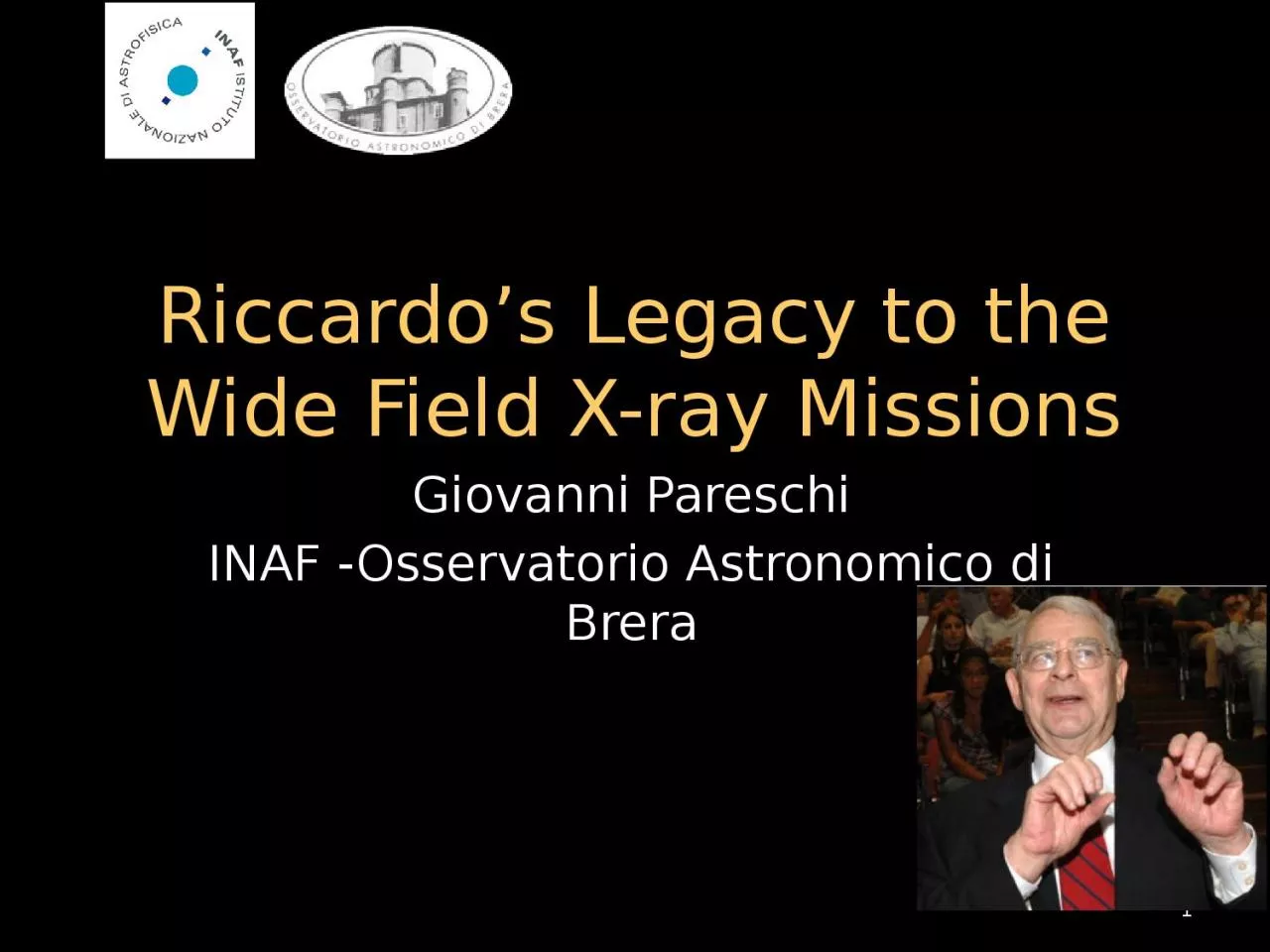

Giovanni Pareschi INAF Osservatorio Astronomico di Brera 1 2 Xray Astronomy towards the next 50 years Conference in Riccardo s honor Milano 1 5 Oct 2012 3 4 httpeduinafitindexphpriccardogiacconiinmilano ID: 1038251
Download Presentation The PPT/PDF document "Riccardo ’ s Legacy to the Wide Field ..." is the property of its rightful owner. Permission is granted to download and print the materials on this web site for personal, non-commercial use only, and to display it on your personal computer provided you do not modify the materials and that you retain all copyright notices contained in the materials. By downloading content from our website, you accept the terms of this agreement.
1. Riccardo’s Legacy to the Wide Field X-ray MissionsGiovanni PareschiINAF -Osservatorio Astronomico di Brera1
2. 2X-ray Astronomy: towards the next 50 years! Conference in Riccardo’s honor, Milano 1- 5 Oct 2012
3. 3
4. 4http://edu.inaf.it/index.php/riccardo-giacconi-in-milano/Anna Wolter, Luigi Stella and contributions by O. Citterio, G. Tagliaferri, A. Renzini. G. Pareschi, G. Trinchieri and the movie of the last interview in Italy with P. Bianucci at the Brera Observatory
5. First grazing Incidence Mirror …and X-ray astronomical optics concepts!Bonaventura Cavalieri, 1632Giacconi & Rossi, 1960
6. The Attempt to Build a Wide-Field X-Ray Telescope (from “Secrets of the Haory Deep)“I started thinking whether it might not be possible to dedicate a smaller mission to this one task, and realized that we could make up for the lesser sensitivity of a smaller mirror with wider field optics, which needed only to be invented.….I discussed this possibility with STScI staff members Chris Burrows and Richard Burg, and we considered optics systems based on two-reflection grazing incidence, in which the reflecting surfaces could be high-order polynomials rather than conics. ….Chris was able to obtain solutions that would achieve angular resolutions of 2.5 arcsec over a field of 28 arcmin radius. We submitted these results in April 1990 in a letter to Astrophysical Journal Letters, which was not published until June 1992.6
7. Schwarzschild & Aplanatic Telescopes1905: Karl Schwarzschild solved the Seidel ‘s equations for spherical aberration and coma finding a relation between parameters capable to make a telescope aplanatic. (Couder 1926 also correction of astigmatism with corved focal plane)“For any geometry, 2 aspheric mirrors allow the correction of SI and SII to give an aplanatic telescope” 7Technological obstacle: Aspherical Optics manufacturingSchwarzschild telescopeKS: f/3.0bS1= -13.5 (Hyperbola)bS2= 1.963 (Spheroid)FoV:2.8 degRMSedge~12’’4 m SC ASTRI Cherenkov telescope, Mount Etna, Sicily
8. Schwarzschild theory first practical application: X-ray telescopes1952a: Wolter solved the Abbe condition for grazing incidence angles. Under the assumption that FP>>L. Coma is small (but it still suffers from field curvature and astigmatism)1952b: H. Wolter solved Schwarzschild condition for grazing incidence angles. Wolter-Schwarzschild design Coma is eliminated (but not field curvature and astigmatism)Perfect on-axis imageryFocal length shorteningWolter I:Typical incidence angle < 1 degUsed for X-rays (E>1 keV) imagingWolter IITypical incidence angle < 10 degUsed for XUV and UV imaging8
9. X-ray telescopes: Polynomial1992: Burrow, Burgs, Giacconi proposed to modify the X-ray telescope (CHANDRA) design with Schwarzschild-like polynomial solution together with the use of small mirror/focal lengths ratioCHANDRA9Burrows, C. J., Burg, R., & Giacconi, R. 1992, ApJ, 392, 760 Solving Seidel conditionsOn axisRay-tracing optimizationOn the FoV Defines the surface profile allowing higher order polynomials admittedOptimization of the imagery quality is on the FoV
10. Polynomial profiles10Mirrors are usually built in the WOLTER-I which provides, in principle, perfect on-axis imagesBut rapid degradation with increasing off-axis angles See Burrows, Burgh and Giacconi (1992), Conconi et al. (2010)Optimization with POLYNOMIAL profiles increase the angular resolution at large off-axis positions but degrading the on-axis performances
11. Small aspect ratio optics mechanical behavior closer to a “belt-like” configuration rather than a “tube-like” border effect errors with a much higher weight in determining the PSF angular resolution more strongly affected by the slope errors caused by out-of-phase azimuthal errorsIncreased difficulty in reaching very good angular resolution11
12. WFXT prototypes in SiC by epoxy replicationWFXT (epoxy replication on SiC) – Ø = 60 cmHeight = 20 cmF. L. = 300 cmHEW = 10 arcsec @ 0.1 keVTests @ Panter-MPE & Marshall XRFRef:. O. Citterio, et al., ”, SPIE Proc., 3766, 198 (1999)Ghigo et al., SPIE Proc., 3766, 209 (1999) Tuesday Jan 20, 2009WFXTPolynomial mirrors developed in Italy for the WFXT mission (1998-2001, see Chincarini et al. ‘98)
13. ParameterDesignNumber of Modules3MaterialFused SilicaConfigurationPolynomial ProfileFocal Length5.5 mMAX & min top diameters0.36 & 1.1 mMAX and min mirror Length (2 reflections)408 & 220 mmCoatingPt + C overcoatingWall Thickness 3 – 1.7 mmNumber of mirror shells /module55Total Weight900 kg (3 modules including structure)WFXT Telescope Configuration (Murray, 2011)
14. HEW across the FOV:WFXT vs. eRosita14eRositaWFXTN.B.: Aspect ratio WFXT = 0.07 – Aspect ratio eRosita = 0.16
15. Survey capabilities comparisonROSATCHANDRAXMMeROSITAWFXTGRASP @1 keV(cm2 deg2)30050240 7504400HEW @2/3 FOV(arcsec)30320305MERIT FACTOR (cm2 deg2 / arcsec2)0.35.50.60.83176GRASP = on-axis Aeff x 0.75 * FOV MERIT FACTOR FOR SURVEY= GRASP / HEW2 15
16. SensitivityWFXT sensitivity provides orders of magnitude increase over other missionsThe good angular resolution easily identifies extended sources and avoids confusionCREDITS: P. Rosati
17. ATHENA: small degradation of the angular resolution off-axis 17Wolter-Schwarzschild (W-S) obeys Abbe sine conditionUse of a small mirror/focal length aspect ratio + optimized mirror profileIMAGER with 40 arcmin diameter FOV at 5” arcsec on average
18. 18W-S design with HEW on average < 1“ with a 10 arcmin diameter FOV thanks to the small aspect ratio3 m
19. Focal length = 5.5m STAR-X (NASA GSFC, 2017) Design directly derived from WFXT 2011
20. Riccardo’s moral testament!20“Contrary to the point of view expressed by several astronomers, I am confident that we still are in a discovery era. Given that the physical nature of 97% of the matter in the Universe is still unknown, I believe there is ample room for frontline research that will provide as many surprises as have occurred in the last decades. I am therefore certain that in the next 50 years x-ray astronomy will reach new heights. I hope the new generation of astronomers will have the opportunity to Learn-Think-Plan and Do as we have had.“